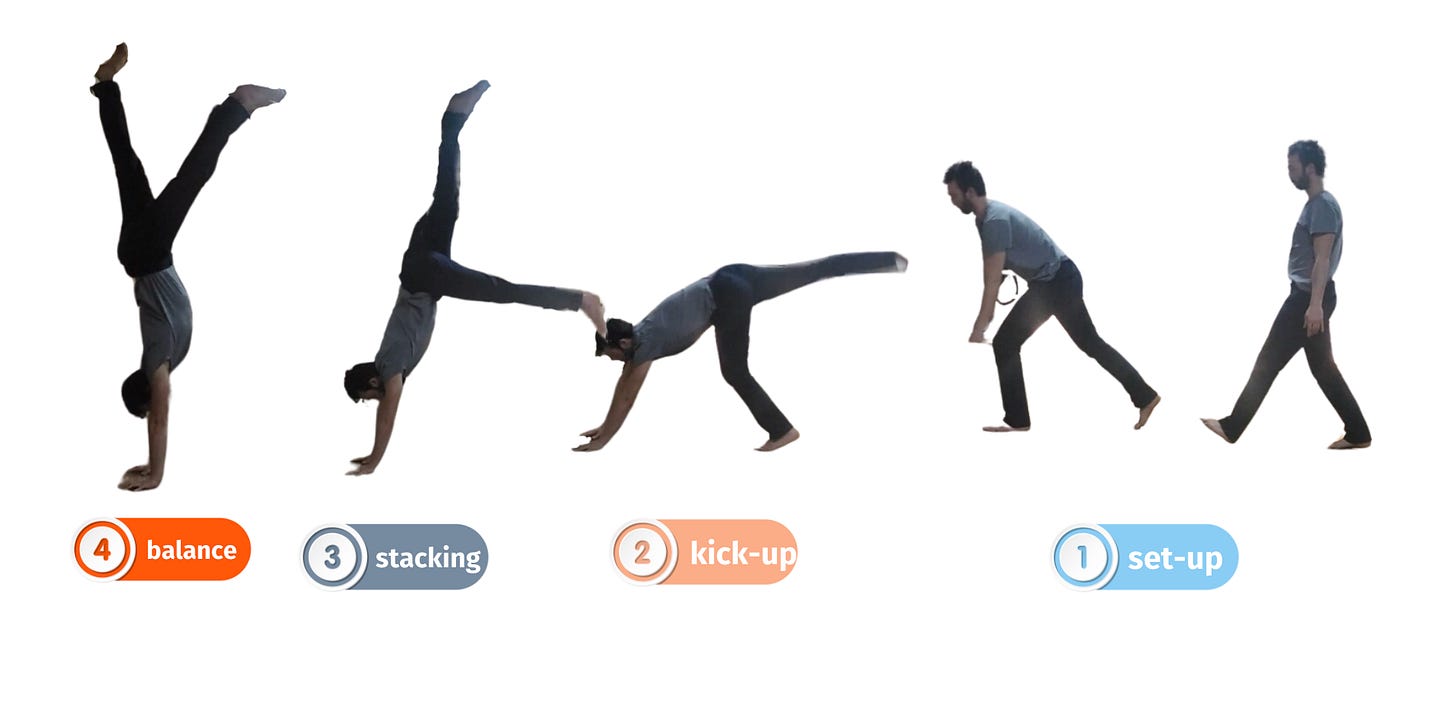Leg scissors: don't waste your time
Feeling the float is not synonymous with learning to balance
I want to use a specific drill to illustrate a much more common phenomena that is likely to waste your training time.
Today, we zoom on the Leg scissors at the wall, a drill that you probably encountered in some shape or form on social media.
Step by step, I’ll explain why it’s probably a waste of your time, and give you the keys to better select drills that have higher ROI for you.
While I am picking on one exercise, it is the philosophy of training that I hope will transpire here.
Scissors: the recipe
Place yourself chest-to-the-wall.
Position your legs in a V shape, or staggered leg position.
Push on the foot on the wall to gain a bit of momentum
Promptly swap the legs to find the wall again.
Supposedly, this teaches you to balance.
After all, aren’t you floating off the wall for a second or so as you swap the legs?
Not so fast.
Zooming in
I am a creature of logic. My career and hobbies have been centered around a burning desire to find the truth and the logic in seemingly complex systems. This was true well before handstands, and it certainly is true for our curriculum at the Handstand Academy.
The first thing I ask when observing a drill, therefore, is:
What part of the handstand is this isolating?
Picture a beautiful handstand from your favorite influencer. You can probably break it down into a series of successive steps:
Set-up: They position their hands on the floor (or stand in their starting position)
Kick-up: They swing the legs to kick-up in the air
Alignment: They align themselves into the desired position
Balance (timing): The momentum is being controlled towards the apex of the movement
Balance (maintenance): They engage their fingers to start the balancing process
Tadaaa: they’re balancing.
The first thing to observe is that the legs do not scissor at any point.
NB: This doesn’t mean the drill isn’t good per se - there are plenty of priming drills that don’t exactly look like what we do freestanding and still have value.
But it is obviously not about mimicking any of those steps at the wall in order to make it better.
This is the first takeaway.
When adding yet another drill into your bookmarked list, ask yourself:
Is this allowing me to better perform any of the 5 stages listed above.
If not, think very hard about what the drill is then about. Discard it if you don’t have an answer.
Deconstructing the scissors
Let’s now flip things around, and look at the drill itself, to derive its purpose:
The take-off part is overlooked.
You are allowed to push on your foot propel yourself off the wall and achieve airtime.
Problem: There will be no wall to push against to place yourself in an ideal position when it’s time to freestand. Developing this co-dependency to the wall is one of the most common mistakes beginners make.
The balancing part is merged with a leg movement.
Problem: it’s hard enough to balance a static handstand. You should probably worry about balancing a dynamic handstand once your static handstand is already strong.
The drill ends back on the wall
Problem: a handstand lives as long as you are off the wall, C2W. In coming back carelessly to the wall, you’re rehearsing the loss of balance as being part of the desired outcome.
The scissors, therefore, are actually an intermediate drill.
One that teaches you the art of continuous leg motion while maintaining balance.
One that obviously requires you first to be able to hold, well, something!
As a beginner and an improver, it is appealing because it makes you experience a second of airtime. But it doesn’t teach you how to take off properly through a viable alignment, how to use your fingers timely to convert 1 into 5 into 50 seconds, how to react from a falling handstand, how to feel the weight shifts in your hands, etc. Nada.
All those are pre-requisites for the actual drill, where you strive to maintain balance while the legs are moving.
And, understanding that, you realise that HOW you perform the drill matters a hell of a lot more than what we see on Instagram.
You need to have achieve control of you static handstand first before beginning the harder phase of leg movement. You need eventually to also exert control over the end position, instead of just slamming yourself on the wall behind, unless you want to rehearse that losing balance is a desirable thing to do.
PS: there is a very small subset of beginners who will stagnate at the C2W take-off stage. That is, they can hold a good alignment at the wall for time and with good body control, but taking off the wall and balancing or bailing from there feels absolutely impossible. The fear defense mechanisms are strong. Knowing the caveats of the scissoring drills, they may benefit from exposing themselves to that split second of airtime, as a way to become more comfortable with the idea of being of the wall, more so that learning to balance. Asking for help to a seasoned teacher is a good idea. Nuance, nuance, nuance.



